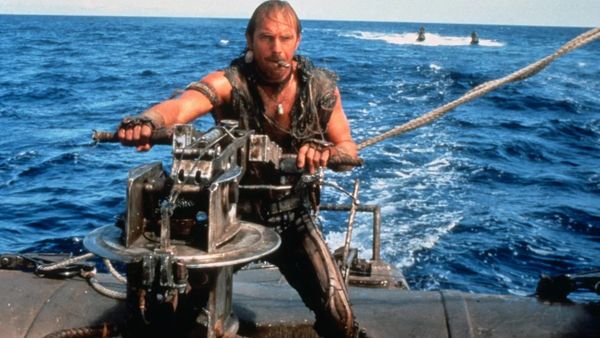WaterWorld (1995)

“Waterworld”: A Daring Vision of a Dystopian Future Directed by Kevin Reynolds
Suggested videos for you:
Released in 1995, “Waterworld” is a bold post-apocalyptic science fiction film directed by Kevin Reynolds, known for his ability to craft visually stunning and ambitious narratives. Starring Kevin Costner, who also produced the film, “Waterworld” presents a unique vision of a future where the Earth is entirely submerged in water due to the melting of polar ice caps. Despite its mixed reviews and troubled production history, the film has since gained a cult following, celebrated for its imaginative world-building and thrilling action sequences.

Set in a desolate, water-logged world, “Waterworld” follows the journey of the Mariner, portrayed by Kevin Costner, a lone drifter and mutant with gills who navigates the vast oceans on a makeshift trimaran. The film’s narrative unfolds as the Mariner encounters a young girl named Enola (played by Tina Majorino), who possesses a map to dry land tattooed on her back. Pursued by the villainous Smokers, a ruthless gang of pirates led by the fearsome Deacon (played by Dennis Hopper), the Mariner must protect Enola and her guardian, Helen (Jeanne Tripplehorn), while embarking on a perilous adventure across the endless sea.

Kevin Reynolds’ direction is marked by its ambitious scope and visually arresting sequences. The film was one of the most expensive productions of its time, and although it faced significant challenges during filming, including budget overruns and harsh weather conditions, Reynolds managed to create a visually immersive experience. The cinematography by Dean Cundey captures the vastness of the ocean, juxtaposed with the starkness of the characters’ plight. The film’s production design, featuring elaborate sets and practical effects, contributes to the sense of realism in this dystopian world.

“Waterworld” is primarily classified as a science fiction action film, but it also incorporates elements of adventure and drama. The film explores themes of survival, environmental degradation, and the quest for hope in a seemingly hopeless world. As the Mariner navigates the treacherous waters, he grapples with his own humanity and the moral complexities of protecting those who cannot protect themselves. The dynamic between the Mariner and Enola serves as a focal point, highlighting the importance of connection and hope in a world stripped of resources and safety.

Kevin Costner delivers a strong performance as the Mariner, embodying the character’s ruggedness and complexity. His portrayal captures the internal struggle of a man hardened by his environment yet capable of growth and compassion. Dennis Hopper’s performance as Deacon is equally memorable, providing a charismatic yet menacing antagonist that heightens the film’s tension. The supporting cast, including Jeanne Tripplehorn and Tina Majorino, adds depth to the narrative, enhancing the emotional stakes of the Mariner’s journey.
Upon its release, “Waterworld” received mixed reviews from critics, with some praising its ambitious vision and action sequences while others criticized its pacing and plot coherence. Despite the initial backlash, the film has found appreciation over the years for its unique premise and ambitious execution. It has also sparked discussions about environmental issues and the implications of climate change, making it relevant in contemporary discourse.
In conclusion, “Waterworld” is an ambitious and visually captivating film that invites audiences into a dystopian future shaped by humanity’s choices. Directed by Kevin Reynolds, the film artfully blends science fiction and action, exploring themes of survival, hope, and environmental degradation. Through the journey of the Mariner and his companions, “Waterworld” serves as a reminder of the resilience of the human spirit in the face of adversity. This film, with its stunning visuals and imaginative world, continues to resonate with viewers, solidifying its place as a distinctive entry in the science fiction genre.











